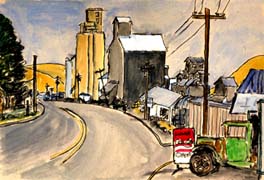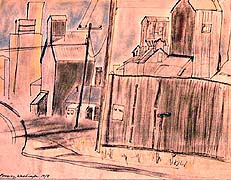American Sabbatical 028: 10/8/96
Roll On Columbia
10/8... Grand Coulee.
When we got up we were in Pomeroy, Washington, a lively farming community on
the edge of the fertile Palouse region. One block off the through
highway was an islanded broadway filled with flowers, and the
town was bookended with big grain elevators. One restaurant did
breakfast (all day), while the other stayed closed til noon. That
kind of neighborly. As for the floral display, since we struck
western Idaho there have been gobs of flowers. Is it the altitude,
or the attitude? The higher West was into drab.
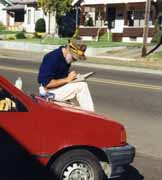
Bryce Draws Again
|
We had pancakes, arguing that it was hard for local chomporia
to screw up breakfast, and AM menus are cheaper. Then we drew
the west end. Felt good to be playing with colors again as morning
ritual.
But where to? The gorgeous Snake, and Walla Walla, lay to the
south, and that way would lead down the Columbia to Oregon. Or
should we gallop across the Palouse to the north and strike the
Columbia at Grand Coulee Dam, arching our shot toward Seattle?
When in doubt go sunwise, to the right. |
We rose up onto the highground, and were back in the gigantic
Iowa of last evening. The contour-plowed dark earth against the
wheatstubble blond made a sinuous quilt. The overlapping hills
make a frozen seascape with crests of fallow grasses, or stubble.
Grant Wood had been at work here with a new palette and a bigger
canvas (we even passed through “Davenport” today). Hidden in the
hollows were tidy farmsteads with their requisite squat silo-clusters.
The native barn appears to be Quonset-dutch, if the ancient ruins
we pass are indicative. Sometimes they have a slight peak and
flared eaves, like a German helmet from 1919. And some are even
red.
| But don’t get accustomed to one style of landscape in the Northwest.
Like Maine weather, it changes every mile. As our path doglegged
north and west we went from Iowa to Wyoming to Dakota to Illinois
to Montana, and back again. Rolling wheatland to dry rangeland
to badland outcrops to flat farmland to rolling pine prairie,
and back into the hilly ranges. The underlying (and erupting)
rock is a shattered burnt-sienna volcanic, with no structure or
coherence, but rich as the fields of heaven. |
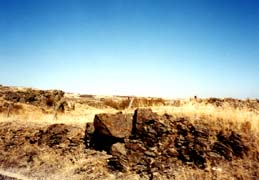
Washington Turf
|
After miles of sweeping grassland, the descent to the Columbia
is abrupt, and you are funneled into the gorge with its forest
of power pylons. Talk about a company town, this place is Electric
City, and hard-wired. And the water-pressure blows you out of
the shower. Must be a plumbers’ nightmare.
|
We discover that tonight will be the last lazer lightshow of the
year at Grand Coulee. Just for us. So off we go to get a seat
in the canyon.
|
|
Pomeroy WA
(Bryce and Peggy)
(Memo #27)
WHAT IS THE LARGEST CONCRETE OBJECT ON EARTH?

Oct. 8 - Conquering the Waters
Who? FDR and PWA
What? major dam project, largest concrete object in the world
Where? on the Columbia River in central Washington state
When? 1930's (New Deal)
How? import of men and materials
Topics: Dams, Columbia River Project, New Deal, PWA, World War
2.
Questions: Who benefits from major dam projects? Why were dams
built during the New Deal? When and how was the GRAND COULEE dam
created?
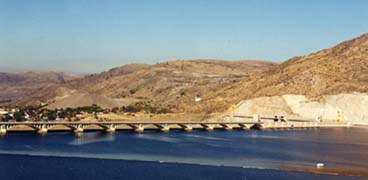
Columbia Gorge
The largest concrete object on earth spans a gorge in north central
Washington. Rising 550 feet from the valley floor and running
just under a mile in width, the Grand Coulee dam is difficult
to believe. The vision needed to wall this river, the scale of
the construction, and the engineering problems encountered, are
mindboggling! I think of the famous seven wonders of the ancient
world; this is one of the seven wonder of modern America.
| Eastern Washington has two of North America’s grandest rivers,
the Snake and the Columbia. Rising in the Rockies to the east
and north, they run through some very dry land in eastern Washington,
join, and flow to the sea. The settlers who came to eastern Washington
thought the fertile soil and occasional rain would enable them
to farm this dry country productively; they were wrong. After
bearing a few seasons, the land was exhausted. So early in this
century pressure mounted from the farming community for dam projects
on the rivers to provide irrigation. |
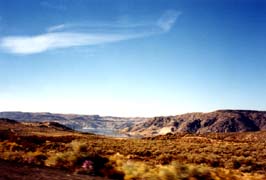
Water in the Dry
|
The Columbia Basin Project and its many dams were launched by
the 1930’s New Deal. As part of the PWA (Public Works Administration),
Franklin Roosevelt’s New Deal sponsored a number of major dam
projects, perhaps the most famous is the TVA (Tennessee Valley
Authority), a series of damn on the Tennessee River. As with most
New Deal projects, the dams had multiple purposes. The monumental
public works were intended to solve the problem of unemployment
in the Depression. The dams would assist farmers, perhaps the
poorest group in America, in several ways: providing water for
irrigation, controlling flood waters, providing electricity to
assist in agriculture (for example, refrigerating milk on dairy
farms), and electrifying farms so that farm families could use
a variety of household appliances. This would spur consumer industries.
Helping larger regions, the dams would create cheap electricity
for cities, and offer cheap electricity and labor to lure industries
into poor agricultural regions (again providing longterm employment).
[People always wonder about the funding - FDR also started the
modern national deficit.] In 1941 the project gained a new and
much more crucial function.
Work began on the Grand Coulee in 1933. The practical problems
were huge. Grand Coulee is far from population centers. We drove
from the nearest small city (Spokane) and it is a LONG dry drive
through semidesert. A new highway and railroad brought materials
in. The dam area had no major town or pool of workers for the
huge project . The PWA built a town, with housing and services,
for the 7000 workers it brought in. Actually, two towns, one for
the engineers on one side of the canyon, and another for the workers
on the other side (class segregation). I couldn’t help wondering
if they located the housing BELOW the dam to inspire attentive
workmanship by the people who lived there. The original stark
rows of identical houses remain, but over the past sixty years
the owners have personalized them with plantings and fancy entries
and architectural details. The dam obviously provides lots of
water for the lawns and gardens. (And the water pressure here
is amazing; turn on a faucet too far and a geyser erupts! ) As
in many places in the west, the people places are green oases.
Look up and you see barren rock hills; at the edge of town the
brown desert begins.
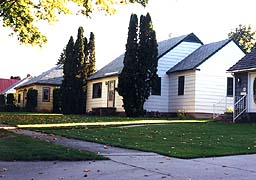
Electric Suburb
|
The main part of town is located up on a plateau, with more recent
housing developments strung along the shelves of land on the canyon
walls. There are amazing views of the canyon walls and the lake
behind the dam. The roadways snake down and around the canyon
walls in great loops. You can cross the river on the two lane
road on top of the dam, or on a bridge that links the two housing
areas below it.
|
Other people were displaced by the dam. Thirteen small towns up
river were drowned by the lake, and the people relocated. The
salmon runs which were a central part of Native American cultures
in the Northwest were disrupted. The engineers tried to provide
salmon ladders to maintain the fishery.
| The organization of construction was a major engineering feat
in itself. How did they bring in, mix, pour this much concrete
(the spillway area cover thirteen acres!)? Thousands of bags of
cement, huge mixing areas, buckets to haul the wet mix, cranes
to haul the buckets. Where do you start? They basically walled
off half the river to start construction on the dam. (I find it
hard to write that, since it takes such vision and such belief
in modern construction). They “anchored” the dam to the canyon
floor after it had been “smoothed”. |
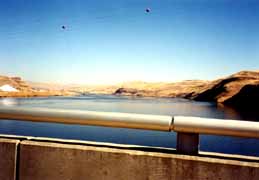
Back of the Dam
|
The dam was poured in stages, with three shifts working around
the clock. The literature gives the numbing statistics. “ By the
end of 1936, a million yards of concrete were in place,” and,
“On May 25 (1939) the CBI Company set a new world record which
still stands, when they placed 20, 685 cubic yards of concrete
in one 24-hour period.” The walls climbed and they built the water
intakes, spillway gates, generators and power plants, the pumping
station to raise the water 1571 feet to the feeder canal.
In 1939 World War 2 began. We entered the war in late 194l after
Pearl harbor, and the Grand Coulee became a crucial part of the
American war effort. Construction was speeded up. The dam to provide
electricity for wartime munitions plants. In particular, the Grand
Coulee provided the huge amount of electricity required to manufacture
aluminum The Pacific northwest became, and still remains, a central
part of the airplane and munition industry.
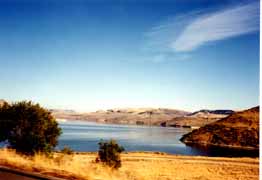
Roll On
|
The statistics are amazing. Grand Coulee is the largest producer
of electricity in the USA, third in the world. It is not as high
as the Hoover dam, but is wider, and produces about five times
the electricity. The spillway is the same area as Niagara Falls
(although narrow and higher). Its total generating capacity is
6,494,000kW.
How do you evaluate the human cost? At least 77 people died in
the construction. Native Americans and other area people had their
cultures transformed. |
The Grand Coulee is an awe-inspiring sight, stark and massive
and quite beautiful. Its beauty inspired the graphic artists that
produced the laser light show that uses the spillway area as a
canvas.We saw the last night show of the year. First, they shut
off the lights at the dam. Then one by one the spillways opened
and a white fall of water blanked the dam. For half an hour lasers
sent multicolor pictures across the face of the dam, as a narrator
detailed its history. Four story horses galloped across and fifty
foot eagles swooped and glided. Music played and lights danced.
It was magic.
10/8 continued.
OK, Lennie, Get This. You’ve got the world’s biggest outdoor theater screen. 5223 feet
wide by 550 feet tall, with built-in waterworks. It gets dark.
You open the 12 overflow gates one by one. It takes 12 seconds
for the white water to flow down the face of the screen below
each gate. Once the whole screen is a roaring waterfall you project
animated linear laser images on the cataract, and along the cliff
walls running another mile to left and right, coupled with a soundtrack
broadcast on loudspeakers around the canyon. And the whole 30
minute program can tell what a magnificent creation this screen
is, and how beneficent we are. Waddya think, Lennie?
Self-promotion by your Department of Reclamation. The multimedia
product delivered in a cool Columbia canyon, under blinking stars,
is a curious mix of New Age wizardry and prewar propaganda. Pre-WWII.
Dramatic baritone renditions of the history of the Columbia and
Grand Coulee (with nods to Native Americans, Mother Nature, FDR,
and the mighty USofA), are illustrated with rapid linear multicolor
animations, sweeping across the full width of the canyon and dam.
These uplifts are intercut with uptempo spacemusic and highspeed
computer-graphic forms, dancing across the dam. Coiling double-helixes
chasing spin-spiral targets as counter-point to outlined stallions
galloping to a text of “ billions of horsepower.”
|
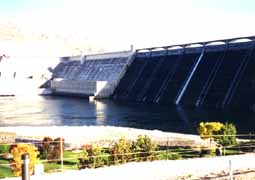
Darkened Screen
|
Granting the limitations of the laser-projection medium, it’s
still interesting that waving flags, Statues of Liberty, the head
of Washington, and screaming eagles continue to be the currency
of communication about public works. You’d think that such techno-gimmickry
would conjure new images, but it’s the same old content. There
were some neat effects. Animals seen from below the water, leaning
down to drink, and dissolving into other images. Linear waves
cresting and breaking across the dam. Five hundred foot long fish
swimming a mile in the blink of an eye. Birds soaring, looping,
diving. Jellyfish turning insideout over a meandering abstract
passage. All the fun you can have with linear forms on a computer
splashed across the megascreen in dazzling colors, their paths
shining in the air.
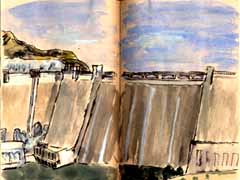
Grand Coulee Dam
(Bryce)
|
A BIG WOW, but with lowgrade TV cartoons and boilerplate as the
stuff! Is that an American metaphor? Megawatts of sugarplums?
And the last message? “We’re not finished with the Columbia yet.
We have the capacity to pump a billion gallons a day to make the
desert bloom.” Support your Department of Reclamation. (I recommend
reading Cadillac Desert before you jump up and cheer.) A nifty
spectacle, put on for a crowd of maybe 35. A last waltz just for
us. Thanks, Uncle. |


